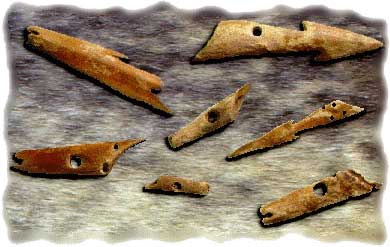
Source Photo: Canadian Museum of Civilization
|
|
 Source Photo: Canadian Museum of Civilization |
| Sea mammals such as seals, walrus and whales have provided the Inuit and other northern peoples with a reliable source of food and materials for thousands of years. The animals were and still are used for clothing, bags, tools, weapons. They are also a rich source oil for heating and cooking. Unlike land mammals which are exposed on the Tundra, sea mammals that inhabit Arctic waters are difficult to track and intercept since they can easily avoid the hunter by diving into the depths of the ocean. The only way our Inuit ancestors could catch the animal while it is swimming is when it surfaced for air. In fact, the Inuit word for these mammal is "Puiji", which means "those who show their noses". An animal may only expose itself briefly before diving back under the water, so a hunter may have only a split second to secure a line or rope to the animal and prevent its escape. To catch a sea mammal in water or on a dry surface like an ice flow, the Inuit hunters developed the harpoon as a spear or javelin like hunting weapon. A harpoon generally has three components, a float bladder; a harpoon fore-shaft assembly and the harpoon head. The harpoon head is the key component since it is the part that pierces the animal’s skin and embeds itself deep in the flesh. If the head is not designed properly, the rest of the harpoon is useless as a hunting weapon. The Inuit developed two varieties of harpoon heads; the barbed harpoon head and the toggle harpoon head. While these heads serve the same purpose, each is designed for a specfic environments; one for open water and the other for packed or ice floe environments. |
 Harpoon Assembly (Source: Inua Spirit World of the Bering Sea Eskimo) |
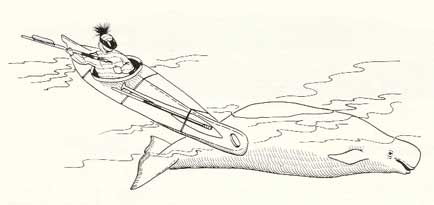 Buluga Whal Hunt On Open Water (Source: Inua Spirit World of the Bering Sea Eskimo) |
| Barbed Head Harpoons Inuit hunting in open waters, all use similar types of barbed headed harpoons. The design is common to coastal communities on the Arctic Ocean and has been around for thousands of years. The harpoon head has barbed points, sharp pointy edges which catch in the flesh when the animal tries to pull away. It is socketed onto the shaft. A line of cord is attached to the head through a line hole near the butt end (the end attached to the shaft), At the far end of the cord is a float. When the harpoon is thrown at the target, the whole fore-shaft assembly provides the weight needed for the harpoon head for pierce the skin or hide of the mammal. If it strikes is good enough to get the head deep into the animal’s muscle, the fore-shaft assembly falls away and the animal held securely by the barbed points and line cord. If the animal struggles hard and flees, the head can be easily pulled out. So, to avoid loosing the catch, the hunter releases the line cord and float bladder which can be seen on the surface of the water. He then follows as the animal attempts to swim away. The natural escape route for a sea mammal is to dive into deeper water; but the float bladder keeps the animal near the surface. Its buoyancy creates more drag than the animal can pull into deep water. The work exhausts the animal which is what the hunter wants to do., Most sea mammals such as seals and walrus are huge (in size and weight) and can easily kill a person when agitated. So, the hunter wants to capture a tired animal, not one that is fresh and ready for a fight. The hunter will follow the animal until it is safe to get close enough to kill it with a lance or club. The hunter still has to be careful when approaching the mammal, because despite being exhausted, many still put up a pretty good fight for survival. This life and death struggle between the Inuit hunter and the sea mammal is one of the reasons why the Inuit have a deep-rooted respect for the animals they hunt. |
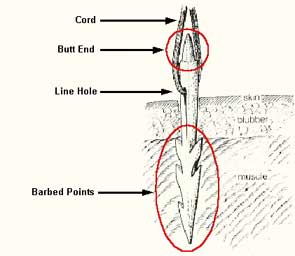 Barbed Head Assembly (Source: Inua Spirit World of the Bering Sea Eskimo) 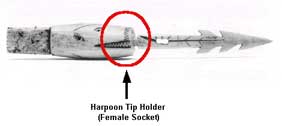 Throwing Harpoon Socket Piece (Source: Inua Spirit World of the Bering Sea Eskimo) 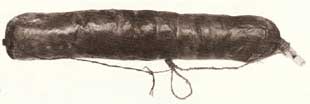 Float Bladder (Source: Inua Spirit World of the Bering Sea Eskimo) 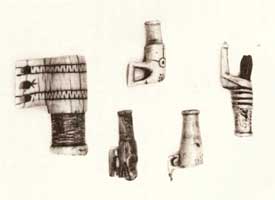 Float Bladder Air Nozzles (Source: Inua Spirit World of the Bering Sea Eskimo) |
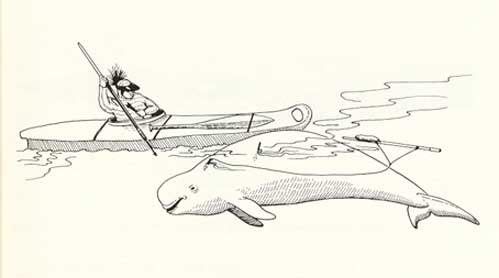 Hunter with a Killing Lance and Club (Source: Inua Spirit World of the Bering Sea Eskimo) |
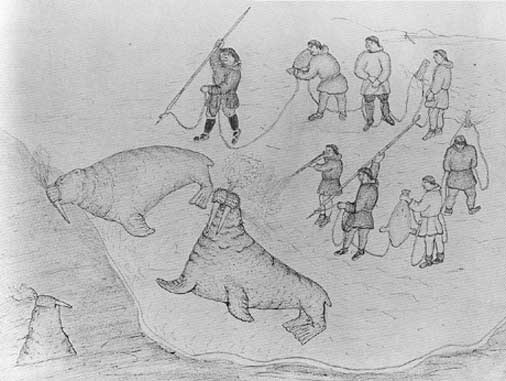 Walrus Hunt on Ice Floe (Circa 1860) (Source: Alaskan Eskimo Life in the 1890, as Sketched by Native Artist) |
| Toggle Harpoon Heads In higher northern areas where the ice is more packed, the toggle harpoon head largely replaces the barbed type. The toggle head is pointed at one end with an angled spur located at the other. The toggle types have a line hole near the midsection of the harpoon head. Much like the barbed type, the toggle head is attached to a fore-shaft assembly which provides the weight to thrust the head through the mammal’s skin and blubber right down into the muscle. When the strike is good enough to get the harpoon head deep into the animal’s muscle, the fore-shaft assembly falls away, Unlike the barbed type harpoon, the line cord is not attached to the fore-shaft assembly. Instead, it is tied to either kayak or stake pulley system which has been pounded into the packed ice. The hunter tightens the line by pulling on it; the angled spur at the base turns the harpoon head sideways (90 degrees), toggling it beneath the blubber. This system holds the animal firmly and allows the hunter to control its movements through the line cord by pulling in or releasing tension on the line cord. The toggle type head also ensures that the animal cannot free itself by pulling out the harpoon head when the line cord catches on blocks of ice or rocks, which is common, in packed ice or ice floe areas. The toggle harpoon head also makes hunting at breathing holes possible because it allows the hunter to pull the animal out of its breathing hole once the harpoon head pierces the skin. |
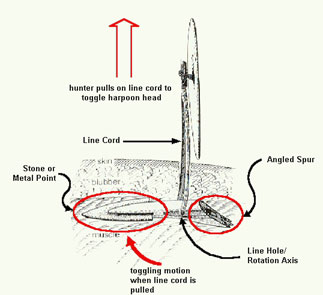 Toggle Type Harpoon Head (Source: Inua Spirit World of the Bering Sea Eskimo) |
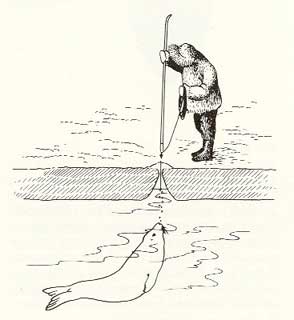 Seal Hunting on Packed Ice (Seal Breath Hole) (Source: Inua Spirit World of the Bering Sea Eskimo) |
| Different sized Harpoons are used to secure different sized sea mammals. These harpoon heads from the Bering Strait a graded for small seals, large seals and belugas, walrus, and whales. They are tipped with stone, bone or ivory points in early days but by the time of Nelson arrived iron and copper were in common use except in part of the Norton Sound where the prohibition against use of metal in Beluga hunting was observed. Source Text: inua spirit world of the bering sea eskimo, |
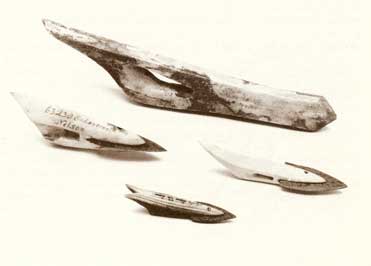 Various Toggle Harpoon Head Sizes (Source: Inua Spirit World of the Bering Sea Eskimo) |
|
|
Many harpoon have carved markings on their sides. These side-markings serve a variety of purposes such as indentifying ownership of the harpoon head or clan of the hunter. Patterns such as curves, circles and dots decorate the head and may portray stylized wolf eyes, raven talons or bear claws.
|
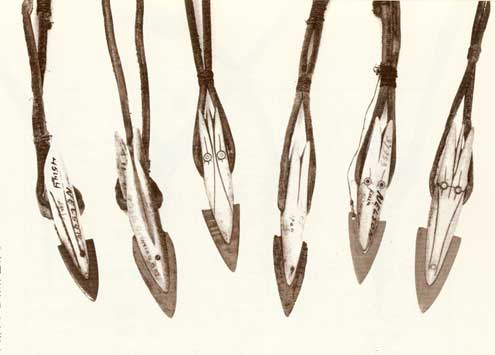 Harpoon Head Designs (Bearing Sea Inuit) (Source: Inua Spirit World of the Bering Sea Eskimo) |
|
Harpoon heads are at the spiritual core of hunting activities since it is the essential part of the hunter’s tools. Harpoon head patterns are passed down from one generation to the next: a parent teaches a child "the right" way to make a harpoon head. This process is built into the social and spiritual values of the hunt and the community. Very few alterations or pattern changes are made during a hunter’s lifetime. Any changes which do occur, are very minor and very difficult to detect except to a trained eye. Some changes can be seen from one generation to the next. These changes provide a means for tracing the development and evolution of Arctic culture in much the same way pottery provides a means to trace the development and evolution of European culture.
|